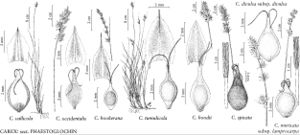Carex spicata
Fl. Angl., 349. 1762.
Plants without conspicuous rhizomes. Culms 10–85 cm, 1.8–2.2 mm wide basally, 0.5–0.9 mm wide distally; basal scales and sheaths usually red or purple tinged. Leaves: sheaths tight, green, fronts hyaline; ligules (3.5–)4–8 mm, longer than wide; widest leaf blades 2–4 mm wide, often papillose adaxially. Inflorescences with 3–8 spikes, 1–4 cm × 6–10 mm; proximal internodes as long as or slightly longer than proximal spikes; proximal bracts to 2 cm; spikes with 5–10 spreading to ascending perigynia. Pistillate scales brown with green 1–3-veined center, lanceolate to ovate, 3.2–4.5 × 1.7–2.2 mm, body slightly shorter and slightly narrower than perigynium, apex acuminate to short-awned. Anthers 1.5–2.5 mm. Perigynia greenish brown finally becoming black and glossy, veinless or to 7-veined abaxially, 4–5.5 × 2.2–2.4 mm, base of body somewhat spongy, thickened, margins serrulate distally; beak 1.5–2 mm, apical teeth 0.3–0.6 mm. Achenes suborbiculate, 2–2.3 × 2 mm. 2n = 58.
Phenology: Fruiting late spring–early summer.
Habitat: Fields, pastures, lawns
Elevation: 0–300 m
Distribution

Introduced; N.S., Ont., Conn., Del., D.C., Ill., Ind., Maine, Mass., Mich., N.H., N.J., N.Y., Ohio, Pa., R.I., Europe, w Asia.
Discussion
Carex spicata is common in some areas and almost certainly under-recorded. The reports of C. spicata from Virginia are erroneous.
The red or purple coloration, though often sparse and highly localized at the base of the plant, is diagnostic for Carex spicata, which is one of the few species in subg. Vignea possessing such coloration.
Selected References
None.
